| e-mail: matt@hhvferry.com |
| [HOME] [LINKS] [HENGIST] [HORSA] [VORTIGERN] [INDEX PAGES: A B C D E F G H I J K L M N O P Q R S T U V W X Y Z] |
| CANADA & ALASKA, SUMMER 2006 Part Three continued: Coho Victoria - Port Angeles Main text written by Richard Seville Pictures © matt@hhvferry.com except where stated |
| Top: The Coho arriving in Victoria. |
| Having re-grouped, it was then a quick drive down the highway to the island Capital, the elegant city of Victoria. The city’s focus is on its famous inner harbour is, dominated by the imposing Empress Hotel, but unlike many, Victoria’s harbour remains a commercial port, and as we were strolling along the pedestrianised waterfront, our next vessel, the veteran Coho, hove into view. Built in 1959 for the newly formed Black Ball Transport Inc, the Coho has spent her entire career on the Victoria to Port Angeles service. Designed by Philip Spaulding of Seattle, her design was soon adopted for the first two BC Ferries’ vessels, the Sidney and the Tsawwassen of 1960, and evolved for their seven-strong V-class. Additionally, the Coho’s basic design was the starting point for the Alaska Marine Highway’s 1963-trio Malaspina, Taku and Matanuska. Incredibly, at forty-seven years old, the Coho is essentially unaltered from new. Her layout is simple, with facilities concentrated on one deck – a panoramic observation lounge forward, leading aft into a reception hall, an amidships lounge and finally a cafeteria aft. In additional, she offers a spacious wrap-around open promenade, and a covered solarium on her upper deck. Her accommodation is spartan – linoleum floors, bare metal bulkheads and open-pipework across the ceilings – and her fittings are basic, essentially consisting of row-upon-row of plastic seating. However, she is very well suited to her 90-minute crossing, and is superbly maintained throughout. The crossing is an attractive one – particularly the departure from Victoria’s inner harbour, and passage away from Vancouver Island with it’s mountainous profile. It is particularly appealing given the lost cost – at less than £7 for a foot passenger single. These prices continue onboard, where a bowl of fresh soup could be bought for approximately £1 from the limited, but appropriate, cafeteria menu. We caught the 15:00 mid afternoon departure from Victoria, planning to return immediately. As we would be crossing from Canada to the US, we ensured we checked carefully beforehand whether this would be OK – US immigration is undertaken on the Canadian side, and fortunately, the very friendly US immigration officer advised this would be fine as she cheerily processed our visa waivers. The Coho departed slightly late, well patronised on our outward voyage, with the vehicle deck seemingly full. |
| Above: The Coho's forecastle, where passengers board in Victoria - the end of the gangway can be seen on the left. |
 |
| Upon our arrival at Port Angeles we lingered onboard, as usual, to photograph her interior, and then made our way ashore to prepare for the return sailing. As we disembarked, we noticed a huge queue waiting to pass through customs – a queue which we were now right at the end of! With just 20 minutes until the return sailing was due to depart, we were mildly concerned, and decided to return back onboard to check whether disembarkation was really required for round-trip passengers. In no uncertain terms, the purser advised us that it was, so we hurried back to join the queue, assured by staff nearby that it would move quickly. Much to our relief, it did, and we soon reached the customs officers – although only with 10 minutes to spare. A few questions later, and we were ready to pass through, when a colleague approached the officer dealing with us. Apparently, other passengers had alerted him of suspicious photography onboard, and having identified us as the ‘suspects’, another, more aggressive, round of questions were thrown at us. Sensible, relevant questions such as ‘Which university did you go to?’, and ‘What subject did you study?’ which clearly would help them objectively assess whether or not we posed a risk to national security. After a few slightly alarming minutes, we convinced them of our benign intentions sufficiently to less us pass through. As we hurried to re-join the Coho, boarding just before the gangway was raised, we could not help but reflect on the incident which had soured our first landfall on US soil – and how depressing it is that things have come to this. Happily, the day perked up almost immediately, as the sun came out and we relaxed on the sundeck under blue skies. All too soon we were back in Victoria, where we wandered the harbour before dinner and drinks at a local bar. It was already late when we headed to our B&B for the night, but we were warmly welcomed by our host, a Scotsman with a maritime heritage including a final stint as a Captain of the Victoria Harbour water taxis. Soon our intentions of an early night were put away, as the conversation flowed and liqueurs were brought out! Two of the party eventually made excuses, and left the Scotch contingent of the Maersk McKinney Møller fan club waxing lyrical into the small hours. |
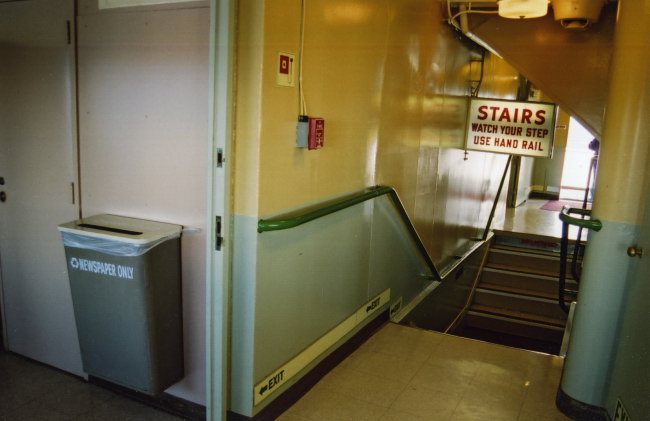 |
 |
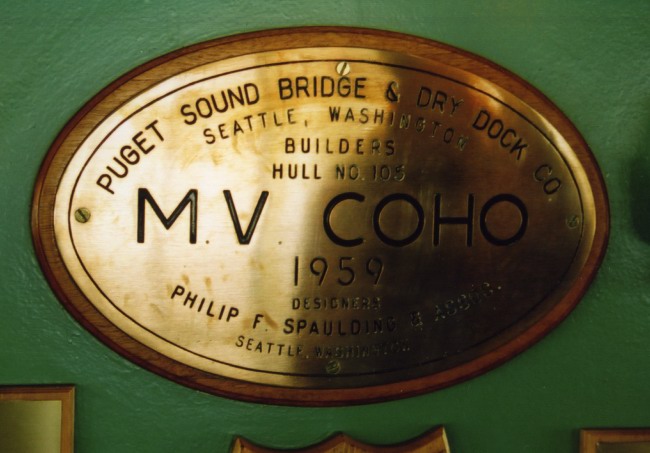 |
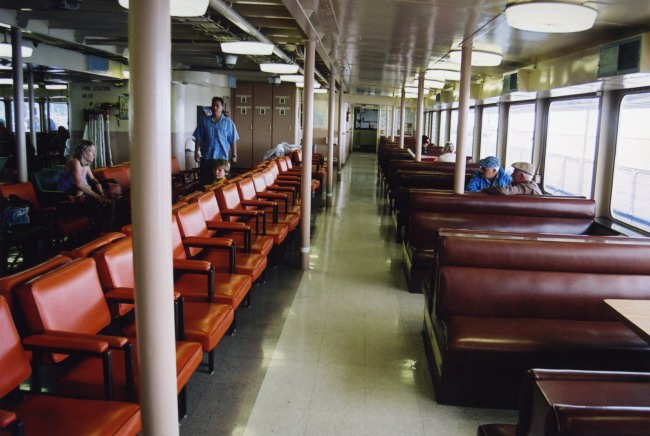 |
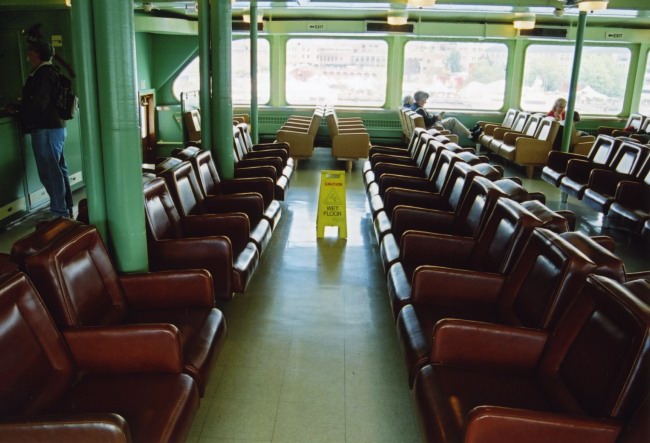 |
 |
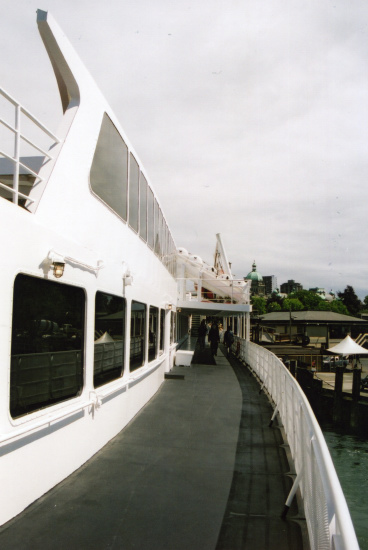 |
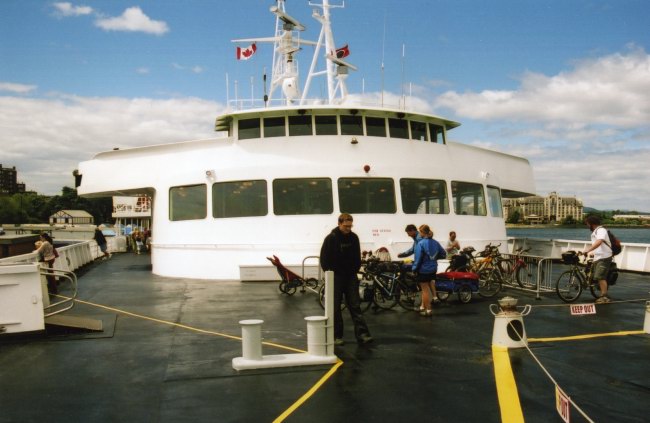 |
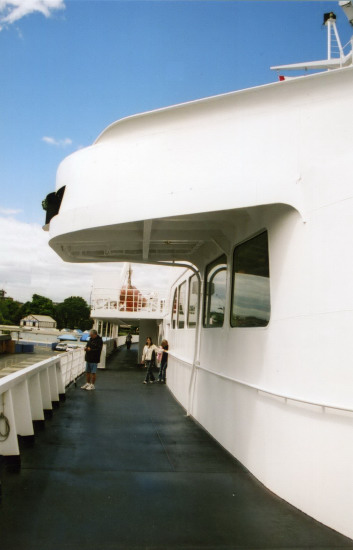 |
 |
| Above and below: The ship's forward lounge, featuring the builder's plate. |
| Above: Just aft of the forward lounge is this lobby with the Purser's Office on the starboard side. |
| Above: The amidships lounge, looking forward on the starboard side. |
| Above: Aft of this can be found the aft stairwell, the distinctive layout of which is a recurring feature on the Coho's half-sisters. |
| Above: The aft cafeteria. |
| Above and below: Streamlined detailing on the Coho's outside decks: this ship is a real child of the '50s. |
| Above: An evening departure for Port Angeles. |